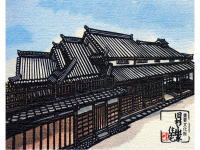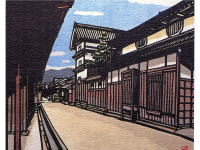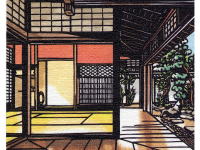富田林寺内町の探訪
I'm glad to intorduce an old town, Jinaimachi, Tondabayashi, Osaka, Japan as a national historic district and heritage site.
It takes 30 minutes from Osaka city to Tondabayashi station by Kintetsu railways. A 10-minutes walk will take you to the historic town.
ギャラリー
residence of the nakamura Family
| 【Tourist guide to Jinaimachi town, Tondabayashi, a historic district and heritage site of Japan, residence of the Nakamura family, Page 1/2】 | ||||
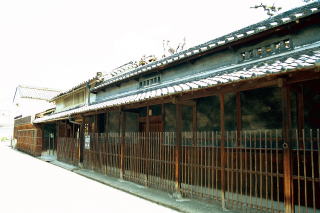 |
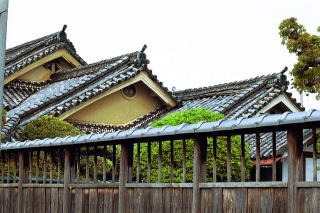 The main house of Yatsumune style architecture (Parlor) |
|||
| History (origin) Nakamura family is one of the old families in Jinaimachi in Tondabayashi. The residence is located almost at the southern tip of the town. The family used to do business as Sadoya and had identified himself as Tokubei since 1734. The founder of Tokuemon was said to be a descendant of the eight headmen of exploitation of Tondabayashi. Though the old family business was not clear, it made a significant development
as a sake brewery, after acquiring the brewing license in 1785. The amount
of sake production in 1785 reached 2,135 koku, the largest among breweries
in Kawachi region. In 1792, Sadoya of the Nakamura family was promoted to be the chief director
of brewing industry that shipped out to the Edo market in Kawachi region.
The products of Sadoya was dedicated to the Tokugawa Shogunate in Edo. |
||||
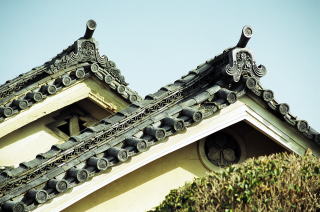 the vent with the design of the family crests of "Sankaibishi" (left) and "Tsurukashiwa"(right) |
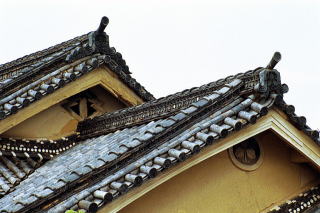 the vent with the design of the family crests of "Sankaibishi" (left) and "Tsurukashiwa"(right) |
|||
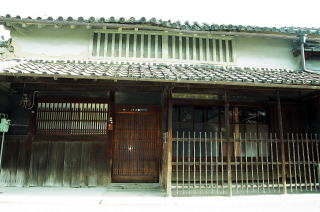 |
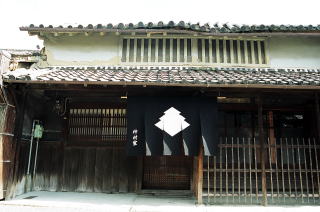 a shop curtain with the design of family crest of "Sankaibishi" or"three-layered-lozenge crest" |
|||
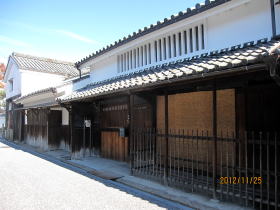 Tsushi-Nikai (the 2nd floor with low ceiling) and Mushikomado (The second floor windows with a plastered grid ) after completion of exterior repairing works. |
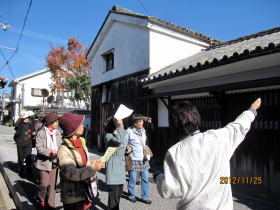 |
|||
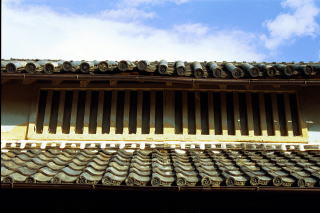 Tsushi-Nikai (the 2nd floor with low ceiling) and Mushikomado (The second floor windows with a plastered grid ) before exterior repairing works. |
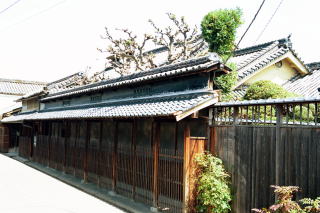 |
|||
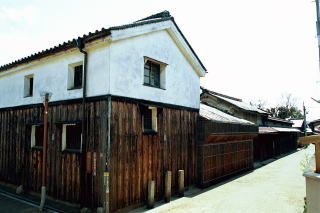 |
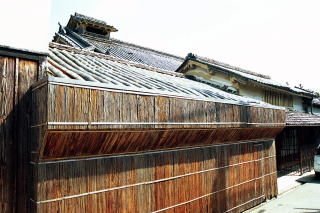 main house of Omoteya style structures frontshop (right) and living quarters (left) |
|||
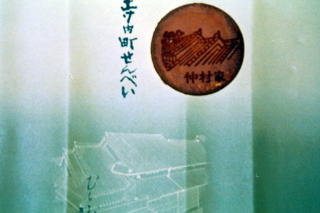 Jinaimachi cookies has used the architectual design of the building. |
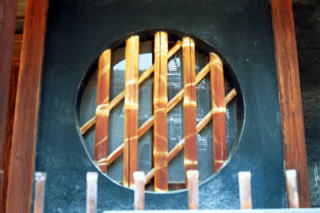 a round bay window has an elaborate grid made of bamboo |
|||
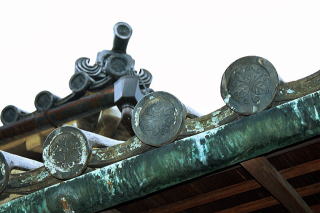 the concave tiles have the family crest of "Tsurukashiwa" engraved. |
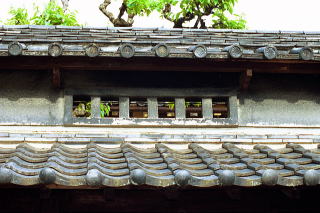 |
|||
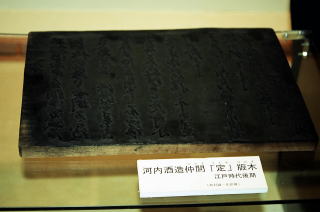 printing block of "regulations of brewery industry association in Kawachi region" (the property of the Nakamura family) |
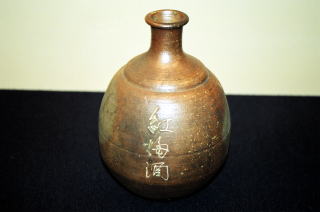 bottle of Koubaishu, wine made of Japanese appricot with red blossoms (the 2nd half of the Edo period, the property of the Nakamura family) |
|||
| 【Tourist guide to Jinaimachi town, Tondabayashi, a histric district and heritage site of Japan, residence of the Nakamura family, Page 2/2】 | ||||
| 【Tourist guide to Jinaimachi town, Tondabayashi, a histric district and heritage site of Japan,Historical buildings】 | ||||
|
||||
Information
Designated as a tangible cultural property of Osaka prefecture in March,
1990.
Not open to the public
(private residence)
Year built: 1782-1783
Location
At the intersection of Tomi-suji Street and (west) Hayashi Street in Jinaimachi
town.
Trade name: Sado-ya
Features of the buildings
The premise occupies one block of town. The architecture of the main house
is Omoteya-Zukuri style and on the north side, there remain an earthen
wall storehouse, a storehouse for tools, a rice granary, a center warehouse,
and food storage for soy sauce pickles and the like.
The architecture of a round bay window has an elaborate grid made of bamboo.
According to the construction record, the year built of the main house
has been found to be 1782-83, and the storefront on western part of the
main building and another house of 3 rooms extending toward the south were
also built at the same time.
The architectural structure of the roof of the parlor is distinguished
by combining as many as three and four ridges together, which has been
called Yatsumune-Zukuri style.
On the gable of roof of the main house, there is a vent that was incorporated
into the design of the family crests representing "Sankaibishi",
which literally means three-layer’ rhombus as its formal crest, can be
seen leftside and "Tsurukashiwa", which literally means vines
and oak as the alternative crest, can be seen rightside.
The design of the family crest of "San-kaihishi" or "three-layered-lozenge crest"has been also incorporated into patterns of round roof tiles. In
addition, the roof tiles of the residence of the Ueno family opposite across
the street also contains the round roof tiles of "Sankaibishi",
the crest of the Nakamura family, as the residence used to be the second
house of the Nakamura family.
For the purpose of preservation, the main house of the Nakamura family
is now covered with a temporary roof.
Many writers and artists visited the Nakamura family. Shoin Yoshida, a
famous patriot of the Choshu domain stayed up about 20 days at the residence
of Nakamura family in Tondabayashi in 1853 while travelling around the
country. Rai Sanyo was also said to stay at the residence.
Remarks:
Omoteya style structure
An architectural style of private residence that a storefront building
with a lower eave, faces the street, and a wider living quarters is separately
placed in the back of the premise and in parallel with the storefront,
and both structures are jointly connected by a narrow ridge consisting
of entrance and corridor, which looks like U-shaped, viewed from the above.
Yatsumune style structure
a large number of ridges is used in the builldings
Tsushi-Nikai
The second floor with low ceiling, which is seen on plastered wall of farmers
houses found in Kansai region.
Mushikagomado (Mushikomado)
The second floor windows with a plastered grid on the plasterer wall of
buildings.
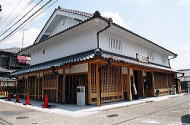
Visitor Center
(Jinaimachi Kouryuukan,
Town Community Center)
Address
9-29, Tondabayashi-cho, Tondabayashi city, Osaka, 584-0033, Japan
TEL.+81-(0)721-26-0110
FAX.+81-(0)721-26-0110
open 10a.m. until 5 p.m.
closed on Monday
Restrooms
Available at Jinaimachi Visitor Center (Jinaimachi Kouryuukan), Jinaimachi
Center and Jinaimachi Tenbou Hiroba (Viewing Terrace)
Visitor Parking
Road width is very narrow in Jinaimachi town. If traveling by car, please
use Tondabayashi Municipal east parking newly opened in February 2014 (Toll
parking).
You can park the minibus for groups and passenger cars for general use.
Only one parking lot available for minibus, you must book it in advance
with Tondabayashi City Hall. A 15-minute walk to the Jinaimachi Visitor
Center and 5 minute walk up to the former Sugiyama family house, an important
national cultural property.
You will note that the large tourist bus for groups is requested to be
parked at the Tondabayashi City Hall No. 2 parking lot alongside the old
Route 170 (It must be booked in advance to City Hall). 20-minute walk to the Jinaimachi
Visitor Center and 10 minute walk up to the former Sugiyama family house,
an important national cultural property. Thank you in advance for your
kind cooperation.
